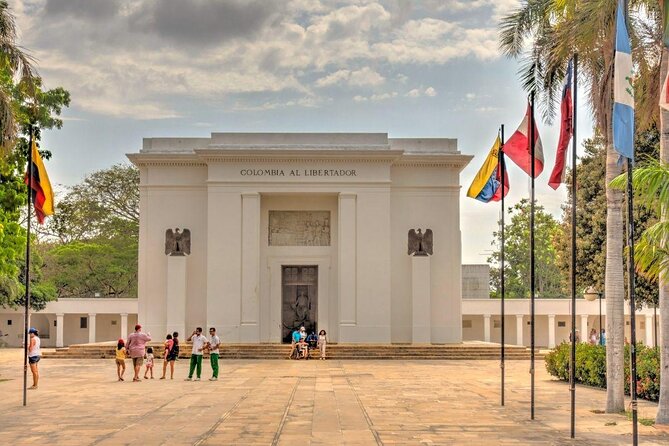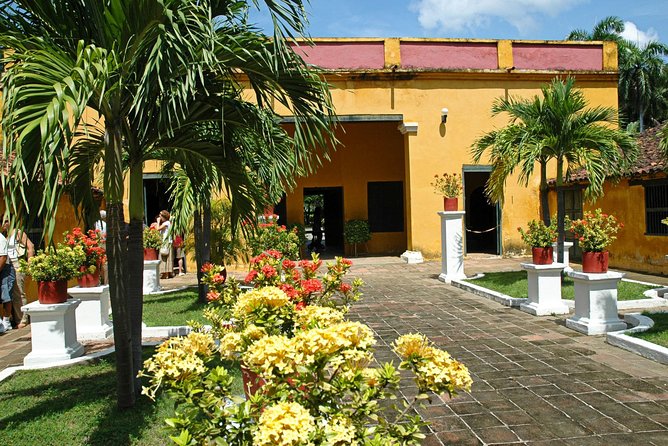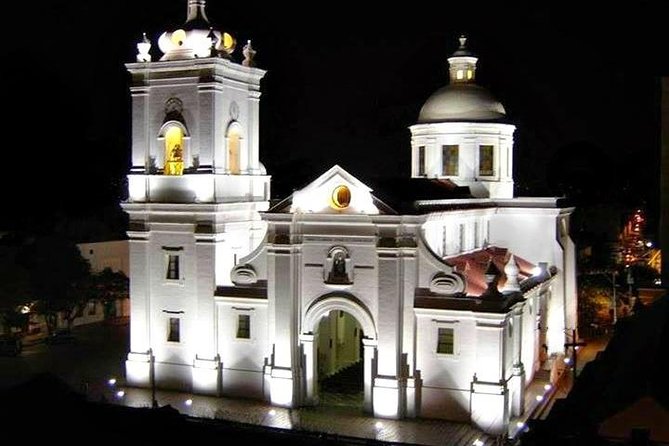Santa Marta’s history is a captivating tale of indigenous resilience, colonial oppression, and eventual independence. Founded by Spanish explorers in 1525, the city’s origins date back to the thriving Tayrona civilization. Over the centuries, it’s weathered the encomienda system, political instability, and economic transformation, emerging as a vibrant commercial hub. Today, visitors can uncover its rich cultural heritage and natural wonders – from historic landmarks to the stunning Sierra Nevada mountains. Intrigued to learn more about this historic Colombian city?
About Your Stay

- Santa Marta has a long history of indigenous habitation, with the Tayrona people establishing a sophisticated civilization from the 1st to 16th century.
- The city was founded by the Spanish in 1525 and became a commercial hub, leading to the exploitation of local indigenous populations under the encomienda system.
- Santa Marta declared independence in 1813 and became part of the Republic of Gran Colombia, marking a period of political instability and economic challenges.
- The city’s strategic port location transformed it into a trade and commerce hub, with key industries including agriculture, particularly coffee and banana cultivation.
- Santa Marta has evolved into a vibrant city that blends its rich history with contemporary culture, attracting travelers with its picturesque boardwalk, beaches, and culinary scene.
Indigenous Inhabitants

The Santa Marta region has been home to various indigenous groups for thousands of years.
The Tayrona people, a sophisticated civilization, flourished in the area from the 1st century AD to the 16th century. They built impressive stone cities, cultivated the land, and developed a complex social structure.
Other groups, like the Kogi and Arhuaco, also inhabited the region and continue to maintain their traditional ways of life today.
These indigenous communities have a deep connection to the land and have played a significant role in shaping the history and culture of Santa Marta.
You can also read our reviews of more historical tours in Santa Marta
Spanish Colonization

In 1499, Spanish explorer Rodrigo de Bastidas became the first European to map the coastline of what’s now Santa Marta. By 1525, the Spanish had established the city of Santa Marta, making it the oldest surviving city in Colombia.
Over the next century, the Spanish consolidated their control, introducing Catholicism and the encomienda system. This led to the exploitation and decimation of the indigenous population.
The city grew as a commercial hub, exporting agricultural products and precious metals. However, it also faced challenges, including pirate attacks and conflicts with indigenous groups.
The Spanish rule in Santa Marta lasted until the region’s independence in the early 19th century.
Independence and Early Republic
Though Santa Marta remained under Spanish rule for centuries, the winds of change were sweeping across the region in the early 19th century. Inspired by the growing independence movement, the people of Santa Marta rose up against the colonial authorities in 1810.
After a series of battles, the city declared its independence in 1813, becoming part of the newly formed Republic of Gran Colombia. The early republican years were marked by political instability and economic challenges, but the people of Santa Marta remained steadfast in their pursuit of self-governance.
This period laid the foundation for the city’s future as a vibrant center of commerce and culture in the emerging Colombian nation.
Economic Development
As the new republic took shape, Santa Marta’s focus shifted toward economic development.
The city capitalized on its strategic location as a port, becoming a hub for trade and commerce. Agriculture, particularly the cultivation of coffee and bananas, emerged as key industries, fueling economic growth.
Investments in infrastructure, such as roads and railways, further bolstered Santa Marta’s position as a commercial center.
While the city faced challenges, including political instability and economic fluctuations, its entrepreneurial spirit and natural resources drove its evolution into a vibrant hub of economic activity, shaping its transformation in the post-independence era.
Cultural Attractions
What cultural attractions define Santa Marta’s rich heritage?
The Quinta de San Pedro Alejandrino, the former hacienda where Simón Bolívar spent his final days, stands as a testament to the city’s history. Visitors can explore the grand estate and learn about the life of the revered South American liberator.
The Museo del Oro Tairona showcases the intricate gold artifacts of the indigenous Tairona people, providing a glimpse into their sophisticated pre-Columbian culture.
Plus, the colonial architecture of Santa Marta’s historic center, with its colorful plazas and quaint streets, offers a captivating window into the city’s past.
Natural Wonders
Beyond its cultural riches, Santa Marta boasts a remarkable array of natural wonders. Nestled between the Sierra Nevada mountains and the Caribbean Sea, the region offers breathtaking landscapes and diverse ecosystems.
Visitors can explore the Tayrona National Park, a stunning coastal haven teeming with pristine beaches, lush tropical forests, and ancient indigenous ruins.
Further inland, the Minca region beckons with its cascading waterfalls, serene rivers, and coffee plantations.
The iconic Pico Cristóbal Colón, the highest coastal mountain in the world, dominates the skyline, providing opportunities for challenging hikes and panoramic vistas.
Santa Marta’s natural splendor is a testament to the region’s remarkable geographic diversity and environmental richness.
Contemporary Santa Marta
Though once known primarily for its historic charms, contemporary Santa Marta has evolved into a vibrant, multifaceted city that seamlessly blends its rich past with a dynamic present.
The city’s picturesque boardwalk, bustling with cafes, boutiques, and art galleries, offers a lively showcase of the local culture.
Nestled alongside the sparkling Caribbean Sea, Santa Marta boasts stunning beaches that attract sun-seekers and water sports enthusiasts alike.
Plus, the city’s thriving culinary scene presents a diverse array of flavors, from traditional Caribbean cuisine to innovative fusion dishes, catering to a wide range of palates.
Questions About Your Stay
What Is the Starting Time of the Tour?
The tour starts at 02:00 pm, according to the tour overview information provided. The confirmation received at booking also indicates this as the starting time for the tour.
Is the Tour Wheelchair and Stroller Accessible?
The tour is wheelchair and stroller accessible, as indicated in the meeting and pickup information. Visitors with mobility needs can easily join the tour and explore the Quinta de San Pedro Alejandrino.
What Is the Price Range for the Tour?
The tour price range is from $48.00, according to the provided information. The tour overview also indicates that free cancellation is available up to 24 hours before the experience starts.
What Is the Cancellation Policy for the Tour?
The cancellation policy for the tour allows for free cancellation up to 24 hours before the experience starts.
What Is the Level of Physical Fitness Required for the Tour?
The tour requires a moderate level of physical fitness. According to the information provided, customers must have a moderate physical fitness level to participate in the tour.
Final Verdict On This Stay
Santa Marta’s history reflects its complex past, transitioning from a Tayrona stronghold to a Spanish colonial outpost, and then an independent commercial center. Though political instability and exploitation have shaped its trajectory, the city has endured, preserving its cultural heritage and natural wonders. Today, Santa Marta continues to evolve, blending its storied past with modern development as a thriving Colombian coastal hub.
More Historical Tours in Santa Marta
More Tour Reviews in Santa Marta
Not for you? Here's more nearby things to do in Santa Marta we have reviewed
- Cartagena: Barranquilla and Santa Marta BILINGUAL GUIDE
- 7 Best Guided Tours In Santa Marta
- 25 Best Tours In Santa Marta
- 3 Best Shopping Tours In Santa Marta
- 2 Best National Park Tours In Santa Marta
- Tour Two Beaches: Cinto and Crystal in Tayrona Park
- Private Transfer Between Santa Marta and Barranquilla (Or Vice Versa)
- Tour Gotsezhy
- Tayrona National Park – Trek to Cabo San Juan
- Tayrona, Snorkel & Beach
- Santa Marta to Santa Marta Airport – Departure Private Transfer
- Artisanal Chocolate: From the Garden to the Table
